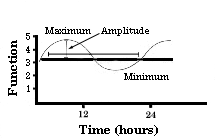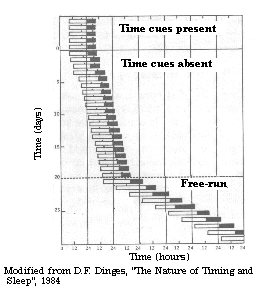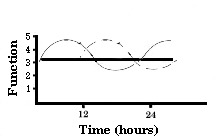
 the human sleep-wake cycle
has a period of 1 day, or goes through 1 complete cycle in a day.
Circadian rhythms, like the sleep-wake cycles discussed later,
are generated by an internal clock that is synchronized to light-dark cycles in the environment and other daily cues.
Circadian rhythms are frequently plotted on an actogram
the human sleep-wake cycle
has a period of 1 day, or goes through 1 complete cycle in a day.
Circadian rhythms, like the sleep-wake cycles discussed later,
are generated by an internal clock that is synchronized to light-dark cycles in the environment and other daily cues.
Circadian rhythms are frequently plotted on an actogram .
An entraining agent (for example,
exposure to bright light) can cause a phase shift (dotted line in the
figure)
.
An entraining agent (for example,
exposure to bright light) can cause a phase shift (dotted line in the
figure) whereby the
activity is started earlier or later in the day.
whereby the
activity is started earlier or later in the day.Like a watch, the circadian clock must be synchronized to local time. For example, animals kept in total darkness will show a free running rhythm that is independent of the local time. A circadian clock is most useful, however, when it is set to local time; the animal must be in sync with its prey, pollinators, and other members of its social group in order to survive. In mammals, the light-dark cycle is a major synchronizer or entraining agent for circadian rhythms[2].